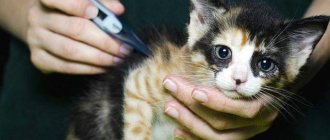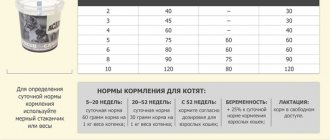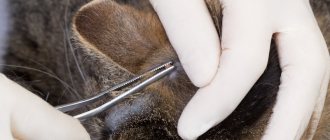Purpose
The postoperative bandage covers the abdominal area and performs several important functions.
- Prevents your pet from trying to lick the post-operative suture. All animals do this reflexively, trying to speed up healing as much as possible. Sometimes it really helps. But after surgery, such behavior can negatively affect the condition of the wound. And from constant licking the seam can completely come apart.
- After sterilization, a cat blanket tightens the edges of the wound, which speeds up regeneration and promotes faster and easier healing.
- The bandage protects the wound from dirt and moisture from outside.
- The blanket prevents the development of bacteria and pathogenic microorganisms. In particular, those that an animal can introduce by scratching its belly or licking itself.
A necessary attribute in the postoperative period
- A high-quality and skillfully applied bandage prevents weakening and stretching of the abdominal wall muscles. Thanks to this, the stomach will not sag.
- A bandage attached to the body prevents the cat from licking the medications used to treat the wound. Many of them are intended only for external use and, if ingested, can greatly harm the health of your pet.
The owner of the animal should be aware that wearing a bandage is not always required after surgery. In some cases it is even harmful. A veterinarian will advise you on the need for a blanket and how long it should be used.
How many days to wear
When deciding how long to continue wearing the bandage, trust your veterinarian
Postoperative care, which is fully the responsibility of the owners, is one of the most important moments, for example, when sterilizing a cat. One of the most frequently asked questions is how long should I wear a blanket?
It is important to understand here that the duration of wearing the bandage directly depends on the complexity of the operation, the size of the wound, the individual condition of the cat and the healing processes. As a rule, after simple surgical interventions, the pet should wear a bandage for 10 to 15 days. However, these terms may vary either more or less.
The problem that you may encounter is that the cat may resist putting on and wearing the blanket, trying with all its might to remove it. Often the pet looks unhappy or is offended by the owners, so there may be a desire to rid the animal of wearing a bandage early. But it is important to remember that the optimal timing for removing the bandage will save your pet from unnecessary problems, and the decision to finally abandon the blanket should be made by a veterinarian.
Buy or make it yourself?
When the need for a postoperative blanket arises, the owner is faced with a choice: purchase the product in a store or make it himself. Each option has its pros and cons.
Advantages of factory products:
- made in compliance with all standards, from environmentally friendly materials;
- high quality, have sufficient strength, the ties do not come off, the edges do not fray;
- special medical breathable fabrics are used for production;
- the design of the blanket fully corresponds to the anatomical structure of the cat;
- Convenient Velcro fasteners are often found.
Pros of homemade blankets:
Pattern
- a bandage tailored to the animal’s individual measurements will fit perfectly and be more comfortable;
- using a pattern made once, you can sew the required number of replacement bandages;
- Considering that a blanket can be made from scrap materials or sewn from old clothes, it will not require material costs.
Considering the low cost of ready-made blankets, you can purchase one, and then compare it with a homemade one in terms of convenience for the cat, and after that choose the most suitable option. Moreover, in almost all clinics the cost of the operation already includes at least one bandage.
Seam processing
treatment of postoperative sutures is an extremely important point
In addition, you should not miss such an important point as processing the seams. After sterilization, the suture is usually located in the lower abdomen of the animal. In this case, it is better not to remove the bandage completely, so you will save yourself the hassle of putting it on later. It will be enough to untie two or three of the outermost rear laces and bend the edge of the fabric so that it does not interfere with access to the treatment area. Antibacterialization of the wound is carried out with medications prescribed by the veterinarian and at intervals recommended by him, depending on the nature of the medical intervention and the general condition of your pet.
How to make it from scrap materials?
If you suddenly need a blanket for a cat, but there is no way to get to a pet store and the animal owner has zero sewing skills, there will still be a way out. In any home you will find things from which you can build a quite decent bandage.
The easiest option is to make a post-operative bandage from tights or leggings. It is enough to select a part of the product that is suitable in width and cut a piece of the required length. After this, slits are made for the paws, and the blanket is put on the cat.
The advantages of this method are undoubted:
- the bandage is made very quickly, the whole process takes no more than 5 minutes;
- no sewing skills or pattern creation required;
- the elastic, soft cover is easily pulled over the animal and does not bother him too much;
- From one tights you can make several blankets.
There are also disadvantages:
- stretch tights (leggings) are not secured to the body in any way, so they constantly curl up and slide down;
- the material of the product is unlikely to withstand the power of cat claws, which means it will become unusable after a couple of active scratches;
- For representatives of small breeds, a blanket made in this way may be too loose and not tightly enough to fit the damaged area.
Do it yourself
The higher the density of the material, the more durable the bandage will be. And, of course, before using tights, they must be washed thoroughly.
A similar method is to use a sock. The front part of the product is cut off and, stepping back about 3 cm from the elastic, holes are cut out for the paws. Socks should be of the appropriate size and good quality, made of thick, elastic fabric. Cheap socks will quickly stretch or begin to fade.
Another option is suitable for those who still have children's clothing for the little ones. An elastic blouse or vest after a little modernization (cut off the excess) may well suit your pet. The advantages of this solution:
- children's clothing is made from eco-friendly, soft fabrics;
- The blouse already has ties, buttons or Velcro.
The downside may be the inconvenience of human clothing for a cat, as well as the difficulty in choosing the appropriate size.
Medical bandage for pet
To close a wound on the body of a domestic cat, ordinary bandaging is not enough. Feeling pain, the animal pulls off the bandage and chews out the surgical threads, risking infection in the suture. Therefore, veterinarians advise putting a sterile blanket on your pet. It is a blanket with holes for the paws and is tied at the back with ribbons. The device covers the lower part of the cat's body from the neck to the tail.
The main property of the product is to prevent pathogenic microflora from entering the surgical incision. Additionally protects the surface of the wound from sunlight and mechanical damage. When treating a sore spot with medications, the coverlet is partially untied without completely removing it.
Other uses:
- protection of the animal in the treatment of purulent ulcers and eczema;
- fixation of drainage;
- ensuring safety during treatment with acaricides;
- isolation of the tumor in the chest area;
- preventing contamination of animal care items.
We suggest you read: Why does a cat growl, bite and hiss for no reason?
The cost of a regular sanitary dressing is quite affordable. In November 2020, it was 75–120 rubles. This is a simple model with ribbons. If desired, the owner can purchase another version of factory tailoring with a pattern and fasteners with buttons, but in this case the price of the product will be from 1,700 rubles. a piece.
How to sew?
Having decided to sew a bandage for a cat after sterilization with your own hands, the first thing you need to do is find a suitable material. Cotton or flannel fabric is best. It must be breathable to provide air access to the wound and prevent suppuration. You should also choose light shades so that you can immediately see any wet spots or dirt that appear. The material should not be loose or colored so that threads or dye particles do not get into the wound.
Ready product
In addition to the fabric, you will need ribbon or braid for ties. It is not recommended to use laces or ropes; they will cut into the skin and cause discomfort to the animal.
The next step is to create a blanket pattern. The easiest way is to find a sample on the Internet and adjust the dimensions to suit your cat. To do this, you need to measure the circumference of your pet’s abdomen. Divide the resulting value by the width of the found pattern. The resulting coefficient will show how many times the existing pattern needs to be reduced or enlarged.
Of course, this calculation is approximate; you may have to slightly change the dimensions according to the individual physique of your pet. But in general, this method shows quite acceptable results.
Once you have obtained the pattern of the desired size, you can proceed directly to sewing. If the selected fabric is thin, it should be folded in half. Cut out the piece, not forgetting to leave seam allowances, fold and hem the edges so that the threads do not come out, and sew ties in the marked places.
If a double blanket is sewn, then the two parts are folded with the wrong side up. Immediately insert the ties into the right places to sew everything with one seam. Stitch, leaving a small hole. Through it, the product is turned right side out and then sewn up.
The postoperative blanket is ready, all that remains is to try it on the cat.
What types are there?
Some owners find it more convenient to use a product that is secured with Velcro.
The classic postoperative blanket is made of natural fabric, mostly cotton. The edges of the product are well processed so that the animal does not experience discomfort when wearing it. The bandage is a rectangular piece with cutouts for the paws; it is attached to the cat’s body with ties. If the laces are inconvenient to use for some reason, you can purchase a Velcro blanket.
Another type of blanket is a stylish garment that is worn on a cat as decoration. This version of the product is also used during weaning of kittens from breastfeeding. The last variety is the protective blanket. It is necessary for short-haired cat breeds, such as Sphynxes, to protect against cold and hypothermia.
How to put on and take off?
If the bandage is put on immediately after the operation, when the animal has not yet recovered from anesthesia, then this does not cause any difficulties. But when it is necessary, for example, to change a soiled bandage, the animal may show dissatisfaction and try to interfere with the owner. Here you will need an assistant who will carefully hold the pet.
How to wear
In both cases, you need to know how to properly tie a blanket for a cat. Most often, a purchased product or pattern is provided with marks on the position of the head, paws and tail, as well as numbering of the ties.
For manipulation, the cat is either placed on its side or placed over a blanket. A standard blanket has seven pairs of ties, they are numbered starting from the front ones. They are tied in the following order:
- the first pair is around the neck;
- the second and third - together in the area of the shoulder blades;
- the fourth - approximately in the middle of the body;
- the fifth encircles the lower back;
- the sixth and seventh cross, fixing the hips and tail.
Do not tighten the tapes too much. The bandage should fit snugly around the cat's body, without sagging, but should not squeeze, preventing it from moving normally. If you can stick a finger between the bandage and the body, everything is done correctly.
The ties should not be too long so as not to cling to all the objects that the pet passes by. The back of the body should be open so that the animal can freely go to the toilet without soiling or wetting the bandage.
If it is necessary to treat the wound, it is not necessary to remove the entire blanket. It is enough to untie only the back ribbons and unscrew the edge, freeing up the damaged area.
Instructions for putting on
Most often, the blanket is secured to the animal’s body using regular ties. Velcro versions are available for sale. Dressing a cat in such a bandage is much easier, but blankets with Velcro are more expensive.
The first putting on of the blanket occurs immediately after the operation. Most often at this time the animal is still under anesthesia or only partially conscious. In this state, the cat does not offer resistance, which greatly simplifies the process. You should be very careful and careful, do not make sudden movements when manipulating the animal’s body: fresh seams can be damaged very easily.
In the future, you will have to repeatedly treat the wounds and put a bandage on an already active animal. It is important to act as calmly as possible. If a cat is nervous and resists, talk kindly to your pet and pet it. Spread the bandage on the table and place the cat on top of it, tummy down.
It will be better if someone helps you the first time - it is much easier to carry out this process together.
What to do if a cat takes off its blanket?
Regardless of whether the owner bought the blanket or carefully made it with his own hands, the cat rarely appreciates the new outfit and tries in every possible way to get rid of it. It is unlikely that you will be able to monitor your pet around the clock, but there are several other options.
Your pet can be placed in a carrier at night
In some cases, the veterinarian will prescribe mild sedatives to calm an overly active animal.
At first, you can limit the cat’s mobility at night, for example, by placing it in a carrier. In a confined space it will be difficult for her to remove the bandage.
An Elizabethan (surgical) collar prevents the removal of the blanket. This is an option in which the cat will focus all its attention on removing the collar and will temporarily forget about the bandage.
You can try to distract your pet: talk, caress, calm.
Sometimes you don't have to resort to tricks. The cat quickly gets used to the blanket and calmly wears it for the allotted time.











